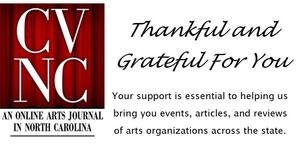Verily at an Episcopal church like St. Alban’s in Davidson, you might say you’ve heard everything after listening to Bach’s “Jesu, Joy of Man’s Desiring” and Beethoven’s mighty melody for Schiller’s “Ode to Joy” played on an open-backed banjo. Sporting kilts and sporrans and hailing from nearby Mint Hill, the Thistledown Tinkers certainly stretched the envelope with their “Celtic Christmas” program at the Music @ St. Alban’s concert series. Banjo picker Tom Eure, who also played violin and mandolin, actually turned out to be the less garrulous member of the duo. The voice of the ensemble, both as singer and emcee, was usually guitarist Trip Rogers, who admits to drawing inspiration from Lynyrd Skynyrd, physically resembles his namesake Kenny Rogers, and delivers vocals that can be described as a cross between Willie Nelson and Paul Lynde.
The Thistledown template for their arrangements usually began with a spirited prefatory section that yielded no clue to the melody that would come, followed by one or two familiar songs played at an unfamiliar tempo and/or with outré instrumentation, and a concluding outro that mirrored the intro. For their opening selection, the Tinkers packaged “We Three Kings” and “God Rest Ye Merry Gentlemen” in a wrapping of slashing from Eure on violin and strumming from Rogers on guitar that recalled evenings I’ve squandered with the regimented Riverdance battalions and their delirious fans. A welcome interlude of relative intimacy followed as Rogers sang “Come and Worship” with his Nelson twang sandwiched around a Eure violin solo. But the Riverdance spirit was not to be escaped that easily as we plunged once more into a manly, thrashing instrumental that saw Rogers resume his fierce strumming and Eure send out more wailing distress signals, with only the briefest outbreak of melody from the violinist wedged into the middle.
Few tunes resist all attempts to wrench from its proper tempo as staunchly as “Come All Ye Faithful,” nor was Eure, a refreshingly unassuming vocalist, about to try. Instead, he switched to his banjo and played his accompaniment in double-time between verses. While he sang, Eure sped the underpinnings more gently, lightly beating percussion on his instrument with his fingers. Breaking away from the singing into the final instrumental duet, the performance radiated a hyper hootenanny merriment. Silent through the first couple of selections, Rogers hit his stride here emceeing, envisioning the Tinkers billed as Celtic Rednecks on PBS, sponsored by AutoZone. That vivid description preceded the most Celtic-sounding selection so far, “What Child Is This” with Rogers’ singing the familiar “Greensleeves” melody. Before launching into “Good King Wenceslas,” Rogers described the Tinkers’ typical mode as a Scottish redneck barn dance, admitting that he had to hunt up the lyrics online and then proving that the carol was indeed susceptible to a hillbilly speed-up. Eure was every bit as proficient on mandolin as he was on banjo.
We detoured into Appalachia for the next instrumental, for which Eure returned to his violin, sprinkling hints of “Deck the Halls” and “Arkansas Traveler” into his mountain riffs. Rogers’ best vocal of the afternoon followed in “Hark! The Herald Angels Sing,” with no detectable gimmickry or Celtic pranks at all, just a nice gentle sway applied to the 3/4 rhythm. That proved to be a perfect lead-in to the concert’s most memorable novelties. While Eure was strapping on his banjo, Rogers gave no hint in his introductory remarks that we were heading to the culmination of Beethoven’s Symphony No. 9. That surprise was compounded with another when we found out how well, on this wild banjo frontier, Beethoven’s stately tune couples with “Joy to the World,” becoming a jolly Christmas carol in the process. After this delight, there was no obfuscating intro to the beloved “Jesu, Joy of Man’s Desiring,” just a straightforward adoration of the melody from Eure without much counterpoint from Rogers – or even Bach’s choral line, though the effect was still pleasing. Eure returned to his violin for the final two selections, though his bow was frequently at rest as he delivered his second vocal on his own composition, “A Cold Christmas,” which had no more Celtic pretensions than the preceding Bach. Our palates were thus cleared for a final redneck romp with a song that lent itself ideally to the Tinkers’ Celtic concept, “Angels We Have Heard on High,” the quickened tempo working especially well in the “Gloria in excelsis Deo” refrain.
More than once, Rogers gazed around the St. Alban’s sanctuary and declared how privileged he felt to be playing there. I also find something special in the way the hall mixes plain unadorned intimacy with an aura of classic symmetry and formality. Rogers admitted at one point that the Thistledown Tinkers were more accustomed to performing near a pool table between a couple of flat-screen TVs. At times, the duo’s disorientation worked in their favor, as when they brought some hard rocker posturing to this incongruous venue. In moderation, those outlaw poses worked for me, but in other ways, the Tinkers need to connect more deftly with their audience and the Music @ St. Alban’s series. Another half hour, at the very least, could be added to their 45-minute program to make the Tinkers more on par with the concert lengths Music @ St. Alban’s subscribers are accustomed to. That extra time might also be channeled into giving more samplings of Eure’s picking on banjo and mandolin, where he has more to say than with his rather generic violin playing. It was a genuine joy to see those German composers steered toward bluegrass, and Rogers’ patter was always a treat. Hopefully, when the Tinkers return to St. Alban’s, it will be less of a departure for them and for their audience.











